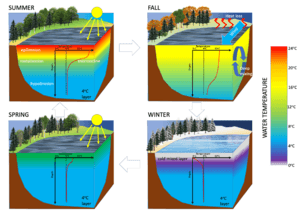Dimictic lake facts for kids
A dimictic lake is a special type of freshwater lake. Its water mixes completely from top to bottom twice a year. This happens because the temperature difference between the surface and bottom layers becomes very small. These lakes are found in places with four distinct seasons, like many parts of North America and Europe.
During winter, dimictic lakes are covered by ice. The water just under the ice is very cold (around 0°C). Below that, the water gets slightly warmer, reaching about 4°C at the bottom. In summer, the surface water (called the epilimnion) gets warm from the sun. The deeper water (called the hypolimnion) stays cold.
But in spring and fall, these temperature differences disappear. The entire lake mixes, allowing water to circulate from the surface to the bottom. This mixing is very important for the lake's health.
Contents
What are Dimictic Lakes?
Dimictic lakes are a type of holomictic lake. This means their water mixes completely at least once a year. For dimictic lakes, this mixing happens twice: once in spring and once in fall. This full mixing helps spread oxygen and nutrients throughout the lake.
Examples of Dimictic Lakes
Many well-known lakes are dimictic. Here are a few examples:
- Lake Mendota in the USA
- Lake Superior in North America
- Lake Simcoe in Canada
- Lake Opeongo in Canada
- Loch Lomond in Scotland
How Dimictic Lakes Change Through the Seasons
Lakes go through different stages of mixing and layering throughout the year. This is called the seasonal cycle. Mixing usually happens in spring and autumn. At these times, the lake water is nearly the same temperature from top to bottom, usually around 4°C. This is the temperature at which water is densest. Because there are no big temperature differences, the wind can easily mix the entire lake.
Spring Mixing
After the winter ice melts, the lake water starts to warm up. Wind helps to mix the water from the surface down. In larger lakes, the top water might still be below 4°C when the ice melts. The sun helps warm it up until the whole water column reaches 4°C.
In smaller lakes, this spring mixing can happen very quickly. As the surface water warms past 4°C, it becomes less dense. This starts to create layers, with warmer water on top. This layering is called thermal stratification.
Summer Layers
During summer, the sun heats the surface of the lake a lot. This creates strong layers of water based on temperature.
- The epilimnion is the warm, top layer.
- The hypolimnion is the cold, deep layer.
- In between is the metalimnion, where the temperature changes quickly. Inside the metalimnion, there's a part called the thermocline. This is where the temperature drops by more than 1°C for every meter you go down.
Because of these stable layers, the water doesn't mix much vertically. This can reduce how much dissolved oxygen reaches the bottom. If a lake has a lot of nutrients (is eutrophic), the deep water can run low on oxygen during summer. This happens in lakes like Lake Erie.
Sometimes, even with layers, lakes can have internal waves. These are like waves that move within the water layers, not just on the surface. Strong winds can cause these waves. In very large lakes, the Earth's rotation (called the Coriolis effect) can also influence these waves.
Fall Mixing
As summer ends, the air gets cooler. The surface of the lake cools down too. This causes the top layers to mix deeper and deeper. Eventually, the entire lake becomes the same temperature from top to bottom. This usually means the water has plenty of dissolved oxygen throughout.
Wind and cooling air continue to mix the water. The lake keeps cooling until it reaches about 4°C. Fall mixing can last for several months.
Winter Layers Under Ice
After the lake cools to 4°C, any further cooling makes the water less dense. This is unusual because most liquids get denser as they get colder. But water is densest at 4°C. So, as the surface water cools below 4°C, it becomes lighter and stays on top.
If there's not much wind, or the lake is deep, a thin layer of cold, light water forms on top of the denser 4°C water. When ice forms, these layers are mostly "locked in."
Even under the ice, things are happening!
- Early Winter (Winter I): Heat from the lake bottom (from the sediment) warms the water slightly, creating a deep layer of 4°C water.
- Late Winter (Winter II): The surface ice starts to melt, and more sunlight passes through the ice. This sunlight warms the upper water, causing some mixing. This mixing helps keep tiny plants (plankton) floating, which is important for the lake's food web and oxygen levels.
Scientists are still studying a lot about what happens in lakes during winter. Even though it's cold, the chemistry and biology under the ice are very active.
See also
 In Spanish: Dimíctico para niños
In Spanish: Dimíctico para niños


